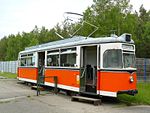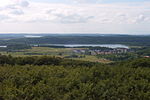Prora station
BinzBuildings and structures in Vorpommern-RügenGerman railway station stubsRailway stations in Germany opened in 1939Railway stations in Mecklenburg-Western Pomerania

Prora (German: Bahnhof Prora) is a railway station in the town of Prora, Mecklenburg-Vorpommern, Germany. The station lies on the Lietzow-Binz railway. The train services are operated by Ostdeutsche Eisenbahn GmbH.
Excerpt from the Wikipedia article Prora station (License: CC BY-SA 3.0, Authors, Images).Prora station
L 29,
Geographical coordinates (GPS) Address Nearby Places Show on map
Geographical coordinates (GPS)
| Latitude | Longitude |
|---|---|
| N 54.443888888889 ° | E 13.564722222222 ° |
Address
Prora
L 29
18609
Mecklenburg-Vorpommern, Germany
Open on Google Maps








